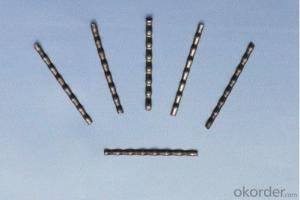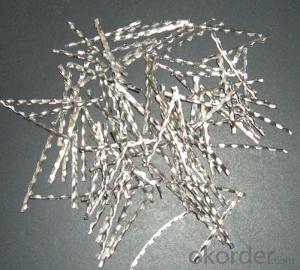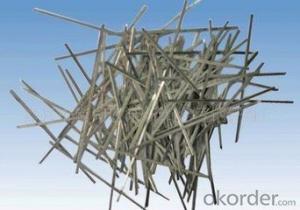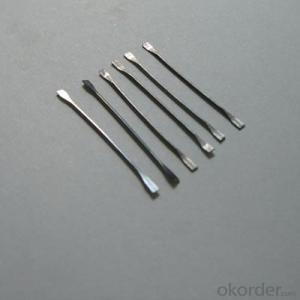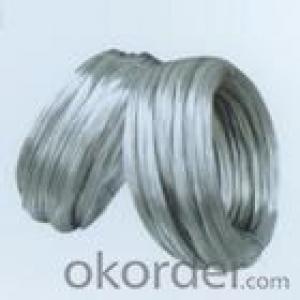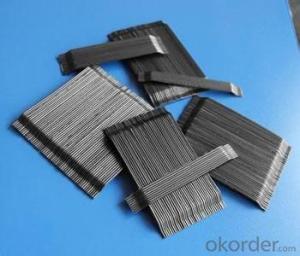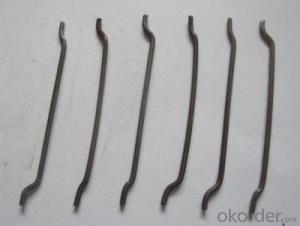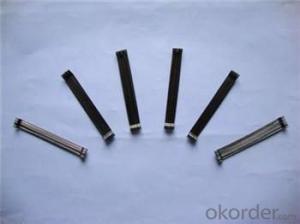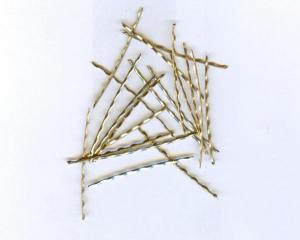Steel Fiber Loose End Hook for Construction
- Loading Port:
- Tianjin
- Payment Terms:
- TT OR LC
- Min Order Qty:
- 1000 kg
- Supply Capability:
- 30000 kg/month
OKorder Service Pledge
OKorder Financial Service
You Might Also Like
Quick Details
Place of Origin: China (Mainland)
Model Number: HT-MC
Material: Color Steel
certificated: ISO 9001
The Products
Our products have steady quality performance, artistic appearance. Its tensile strength, bend ductility, fatigue resistance all reach
or exceed the standerd of country's stipulation.
Our main produces are RPC coppercoated steel fiber, steel belt cuuting steel fiber and steel wire cutting steel fiber. Anual output is
15000 tons.Our raw materials are purchasing from famouse brand company in demestic.
Our products are widely used in expressway, high speed railway, industrial terrace, tunnel, bridge, airport runway and so on.We have
sold our steel fiber to lots of province of China and a lot of countrys and areas, such as korea, japan, austrilia mid-east, south asia
and so on.
1. Directadding steel fibers to the belt,the rows of steel fiber as a whole,each of the concrete uniformly dispersed Corner
2. A water-soluble glue starts to dissolve,in a row of steel fibers in a dispersion premise,dispersed again in every corner of the monofilament fiber,showing a perspective view in the concrete of the fiber web, which play the role of an overall reinforcement.
3. Compare to the monofilament fiber,the glued steel fiber wouldn't be tied up,to ensure that the fibers in the concrete mixing does not agglomerate,distributed evenly.
Specifications
model
| length(mm) | diameter(mm) | L/D
| Tensile strength | The number of per kg |
Boen-Cp 65/35 | 35 | 0.55 | 65 | ≥1100 | 14500 |
Boen-Cp 80/50 | 50 | 0.62 | 80 | ≥1100 | 8100 |
Boen-Cp 100/60 | 60 | 0.62 | 100 | ≥1100 | 6800 |
Boen-Cp 80/60 | 60 | 0.75 | 80 | ≥1100 | 4600 |
Boen-Cp 65/60 | 60 | 0.90 | 65 | ≥1000 | 3200 |
Boen-Cp 55/60 | 60 | 1.05 | 55 | ≥1000 | 2300 |
Picture
PP bag
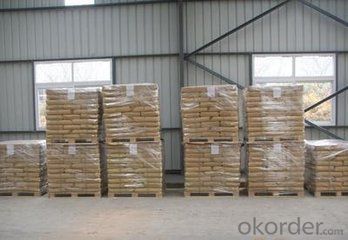
any type
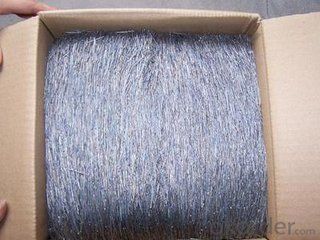
steel fiber

FAQ
Steel fiber
1) greatly improve concrete bonding and tensile strength
(2) improve mechanical performance concrete
(3) prevent the damage to the concrete
(4) decrease the danger from crack of the concrete
(5) provide exceptional load stability and durability
- Q:Can melt extract stainless steel fiber be used in tunnel boring machine applications?
- Yes, melt extract stainless steel fiber can be used in tunnel boring machine applications. Stainless steel fibers are known for their high strength and corrosion resistance, making them suitable for use in harsh environments such as tunneling. These fibers can reinforce the concrete used in tunnel construction, improving its overall mechanical properties and durability. Additionally, stainless steel fibers can enhance the crack resistance of the concrete, reducing the risk of structural failure. Therefore, the use of melt extract stainless steel fiber in tunnel boring machine applications can help increase the longevity and safety of tunnel structures.
- Q:What is the effect of melt extract stainless steel fiber on the durability of tunnel linings?
- The use of melt extract stainless steel fiber in tunnel linings has a significant impact on their durability. Stainless steel fibers are known for their high tensile strength, corrosion resistance, and thermal stability, making them an ideal choice for reinforcing tunnel structures. One of the main effects of melt extract stainless steel fiber is its ability to enhance the crack resistance of the tunnel linings. When tunnels are subjected to various loads and stresses, such as ground movement or heavy traffic, they are prone to developing cracks. However, the addition of stainless steel fibers helps to distribute the load more evenly, thereby reducing the formation and propagation of cracks. This improvement in crack resistance ultimately enhances the durability of the tunnel linings. Furthermore, melt extract stainless steel fiber also improves the overall strength and stability of tunnel linings. The fibers reinforce the concrete matrix, providing additional strength and preventing the formation of weak points. This increased strength can help the tunnel linings withstand external forces and pressure, such as water infiltration or ground settlement, thereby prolonging their lifespan. Additionally, stainless steel fibers exhibit excellent resistance to corrosion, ensuring the long-term durability of tunnel linings. Tunnels are often exposed to harsh environmental conditions, including moisture, chemicals, and temperature variations, which can accelerate the degradation of traditional reinforcement materials. However, stainless steel fibers are highly resistant to corrosion, making them a reliable choice for enhancing the durability of tunnel linings. Overall, the effect of melt extract stainless steel fiber on the durability of tunnel linings is significant. It improves crack resistance, enhances strength and stability, and provides excellent corrosion resistance. By incorporating these fibers into tunnel construction, engineers can significantly increase the lifespan and reliability of tunnel linings, ensuring their long-term durability.
- Q:Does melt extract stainless steel fiber improve the durability of concrete in marine environments?
- Yes, melt extract stainless steel fiber can improve the durability of concrete in marine environments. Stainless steel fibers are resistant to corrosion, making them ideal for use in marine environments where concrete is constantly exposed to saltwater and other corrosive elements. These fibers provide reinforcement to the concrete, increasing its tensile strength and reducing cracking, which can further protect the concrete from the damaging effects of water and salt. Additionally, stainless steel fibers can enhance the overall durability and longevity of concrete structures in marine environments by improving their resistance to abrasion and impact. Therefore, the use of melt extract stainless steel fibers in concrete can significantly enhance its durability in marine environments.
- Q:Can melt extract stainless steel fiber be used in pre-stressed or post-tensioned concrete?
- Certainly! Melt extract stainless steel fiber is capable of being utilized in both pre-stressed and post-tensioned concrete. By incorporating stainless steel fibers into concrete, its tensile strength and resistance to cracking can be enhanced, rendering it suitable for applications like pre-stressed or post-tensioned concrete. The exceptional characteristics of stainless steel fibers, such as their high tensile strength, corrosion resistance, and durability, make them an ideal reinforcement material for concrete structures that experience substantial loads or potential cracking. Moreover, the melt extract stainless steel fibers can be effortlessly blended into the concrete mixture and evenly dispersed throughout the structure, ensuring uniform reinforcement. Consequently, melt extract stainless steel fibers represent a viable choice for reinforcing pre-stressed or post-tensioned concrete.
- Q:How does melt extract stainless steel fiber improve the bond strength of concrete?
- Melt extract stainless steel fiber is known for its ability to significantly improve the bond strength of concrete. The unique properties of this fiber contribute to its effectiveness in enhancing the bond between the concrete matrix and the reinforcement. Firstly, the melt extract stainless steel fiber has a high aspect ratio, meaning it has a long and slender shape. This characteristic allows the fiber to penetrate deeply into the concrete matrix, resulting in a larger surface area for bond formation. As a result, the bond strength is improved as the fiber forms a strong interlocking network within the concrete. Secondly, the stainless steel fiber is manufactured using a melt extraction process, which ensures a clean and uniform composition. This uniformity and absence of impurities contribute to a better bond with the concrete matrix. The smooth surface of the fiber also prevents any weak points or irregularities that could weaken the bond strength. Additionally, the stainless steel material itself possesses high tensile strength and excellent corrosion resistance. These properties allow the fiber to withstand the forces and environmental conditions that may degrade the bond strength of traditional reinforcement, such as corrosion or chemical attack. Therefore, the use of melt extract stainless steel fiber in concrete significantly improves the durability and long-term performance of the structure. In summary, melt extract stainless steel fiber improves the bond strength of concrete by providing a high aspect ratio for better penetration, uniform composition for a consistent bond, and strong material properties to withstand external forces. This fiber reinforcement enhances the overall strength and durability of the concrete structure, making it an excellent choice for various construction applications.
- Q:Does melt extract stainless steel fiber improve the resistance to impact of shotcrete?
- Indeed, the incorporation of melt extract stainless steel fiber in shotcrete does indeed enhance its resistance to impact. Shotcrete, a technique involving the high-velocity spraying of concrete onto a surface, benefits from the inclusion of stainless steel fiber, which serves to fortify its impact resistance. Acting as reinforcement within the shotcrete, these stainless steel fibers bolster its durability and capacity to withstand forces of impact. By absorbing and dispersing the energy arising from impacts, these fibers decrease the likelihood of cracks, spalling, and other forms of damage. Moreover, the stainless steel fibers augment the shotcrete's tensile strength, rendering it more resistant to cracking and elevating its overall structural integrity. Undoubtedly, the addition of melt extract stainless steel fiber to shotcrete yields a significant enhancement in its resistance to impact, establishing it as the preferred choice for applications where impact resistance is paramount, such as tunnels, bridge decks, and retaining walls.
- Q:What are the environmental benefits of using melt extract stainless steel fiber in concrete?
- Using melt extract stainless steel fiber in concrete offers several environmental benefits. Firstly, stainless steel is a highly durable material that has a long lifespan. By incorporating stainless steel fibers into concrete, it increases the overall durability and lifespan of the concrete structure. This means that less concrete will need to be produced and replaced over time, resulting in reduced resource consumption and waste generation. Additionally, the use of stainless steel fibers can enhance the structural integrity of concrete, allowing for reduced thickness and weight of concrete structures. This, in turn, reduces the amount of concrete required for construction projects, resulting in lower carbon emissions associated with concrete production. Furthermore, stainless steel fibers can improve the crack resistance and impact resistance of concrete, reducing the need for frequent repairs or replacements. This leads to reduced maintenance and repair activities, resulting in lower energy consumption and waste generation associated with concrete maintenance. Moreover, the use of stainless steel fibers in concrete can enhance its resistance to corrosion and chemical attack, thereby increasing its lifespan in harsh environments. This reduces the need for premature demolition and reconstruction, resulting in less waste generation and resource consumption. Lastly, stainless steel is a recyclable material that can be reused after the end of its useful life. This means that stainless steel fibers used in concrete can be recovered and recycled, reducing the demand for new stainless steel production and minimizing the environmental impact associated with its extraction and manufacturing processes. Overall, the environmental benefits of using melt extract stainless steel fiber in concrete include reduced resource consumption, lower carbon emissions, reduced waste generation, and increased recyclability.
- Q:Can melt extract stainless steel fiber be used in lightweight aggregate concrete wall panels?
- Yes, melt extract stainless steel fiber can be used in lightweight aggregate concrete wall panels. Stainless steel fibers are commonly used as reinforcement in concrete to enhance its tensile strength, crack resistance, and durability. Lightweight aggregate concrete, which is made by replacing traditional coarse aggregate with lightweight materials such as expanded clay or shale, offers several advantages including lower dead load, better thermal insulation, and improved fire resistance. By incorporating melt extract stainless steel fibers into lightweight aggregate concrete, the resulting wall panels can benefit from the additional reinforcement provided by the fibers. This reinforcement helps to prevent cracking and improve the overall structural integrity of the panels. Additionally, stainless steel fibers are corrosion-resistant, which is crucial for applications in concrete exposed to harsh environments or moisture. The use of melt extract stainless steel fibers in lightweight aggregate concrete wall panels can also enhance their resistance to impact and blast loads, making them suitable for applications in areas prone to earthquakes or explosions. Furthermore, the addition of stainless steel fibers can improve the ductility and flexural strength of the panels, allowing them to better withstand external forces and deformations. Overall, melt extract stainless steel fibers can be successfully used in lightweight aggregate concrete wall panels to enhance their mechanical properties, durability, and performance in various applications.
- Q:Can melt extract stainless steel fiber be used in fiber-reinforced polymers?
- Fiber-reinforced polymers (FRPs) can benefit from the utilization of melt extract stainless steel fiber. These fibers, obtained through a specialized process, offer uniformity and high quality. By incorporating stainless steel fibers into polymer matrices, the mechanical properties of FRPs, such as tensile strength, flexural strength, and impact resistance, can be improved. This enhancement makes the composite material suitable for applications that demand a high strength-to-weight ratio. Furthermore, the addition of stainless steel fibers enhances the fracture toughness of FRPs, making them more resistant to crack propagation. This characteristic is especially important in situations where impact resistance plays a significant role. Moreover, the corrosion resistance offered by stainless steel fibers proves advantageous in environments with harsh conditions, including moisture, chemicals, or high temperatures. These fibers prevent corrosion of the composite material, thereby increasing its lifespan and reliability. Overall, the integration of melt extract stainless steel fibers into FRPs significantly boosts the mechanical properties and durability of the composite material. Consequently, it becomes suitable for a wide range of applications in industries such as automotive, construction, aerospace, and marine.
- Q:What is the effect of melt extract stainless steel fiber on the spalling resistance of concrete?
- The effect of melt extract stainless steel fiber on the spalling resistance of concrete is that it significantly improves it. The addition of stainless steel fibers to concrete helps to prevent spalling, which is the breaking off or chipping of the concrete surface due to high temperatures. The fibers increase the tensile strength and flexibility of the concrete, making it more resistant to thermal stresses and reducing the risk of spalling.
1. Manufacturer Overview |
|
|---|---|
| Location | |
| Year Established | |
| Annual Output Value | |
| Main Markets | |
| Company Certifications | |
2. Manufacturer Certificates |
|
|---|---|
| a) Certification Name | |
| Range | |
| Reference | |
| Validity Period | |
3. Manufacturer Capability |
|
|---|---|
| a)Trade Capacity | |
| Nearest Port | |
| Export Percentage | |
| No.of Employees in Trade Department | |
| Language Spoken: | |
| b)Factory Information | |
| Factory Size: | |
| No. of Production Lines | |
| Contract Manufacturing | |
| Product Price Range | |
Send your message to us
Steel Fiber Loose End Hook for Construction
- Loading Port:
- Tianjin
- Payment Terms:
- TT OR LC
- Min Order Qty:
- 1000 kg
- Supply Capability:
- 30000 kg/month
OKorder Service Pledge
OKorder Financial Service
Similar products
New products
Hot products
Related keywords


